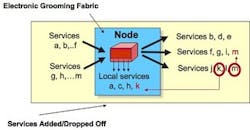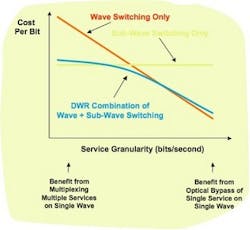Reconfigurable optical networks: Paving the way for dynamic wavelength routing
By combining electrical grooming and wavelength-selective switching (WSS) into a dynamic wavelength routing (DWR) solution, operators can address both full-wavelength and sub-wavelength services at cost points that render ROADMs economical today while meeting increasing bandwidth demands in the future.
By Vinay Rathore, Ciena
Under traditional network-planning models, network operators must identify in advance the end points of each optical circuit and the maximum amount of bandwidth that circuit will require--or risk wasting optical resources. Reconfigurable optical add/drop multiplexers (ROADMs), by contrast, enable automated network reconfigurations, providing a significant improvement over existing planning models. ROADMs enable any single wavelength or arbitrary group of wavelengths to be dropped at any point in the network and then added back at any point in the network, including the point at which they were dropped.
The ability to reconfigure circuits in the optical domain is critical, as today's end user applications are bandwidth hungry and require rapid changes in network configuration. In the past, optical wavelengths were converted to the electrical domain, where it is much easier to reconfigure circuits, and then converted back to the optical domain. Such OEO conversions are cost effective for lower speed services but become inefficient for high-speed services. Instead, the network flexibility that exists in the electrical domain--including the ability to add, drop, and cross-connect individual services--must be extended to the optical domain. Network nodes built with ROADM technology provide the flexibility in optics that once was reserved strictly for the electrical domain.
While most services today remain at sub-wavelength (< 2.5-Gbit/sec or < 10-Gbit/sec) data rates and likely will for some time, a combination of electrical aggregation and grooming working hand-in-hand with ROADM functionality provides the ultimate in network flexibility: dynamic wavelength routing (DWR).
Evolution of ROADM technology
ROADM is not one technology but three succeeding generations of technologies characterized by increasing levels of functional integration. First-generation ROADMs, for example, were built from an array of 2x2 switches sandwiched between full-channel optical multiplexers/demultiplexers.
The first-generation ROADM architecture is inadequate for a number of reasons. First, it creates a severe optical bandwidth narrowing effect that degrades signal performance. The situation is analogous to aligning the holes in a series of needles; slight misalignments accumulate to reduce the effective "passband" of the cascade. This effect is especially damaging for networks carrying 10-Gbit/sec signals, which fill a larger portion of the filter window. First-generation ROADMs also create nonlinear dispersion effects for which standard dispersion compensating fiber (DCF) is insufficient. As such, wavelength lockers are required on every transmitter, adding extra cost and hindering interoperability with third party or 'alien' wavelength signals.
Moreover, first-generation ROADM architecture does not support port tunability. Specific channels can be accessed only through predetermined add/drop ports on a node. To guarantee access to any wavelength, network operators must deploy hardware for each channel in their WDM channel plan at initial installation, a process that adds to the cost and complexity of the node--particularly if the node itself requires only a small number of channels.
Second-generation ROADMs are designed to address the shortcomings of first-generation technology. In this type of architecture, a DWDM signal enters the node and is tapped off and sent through a series of tunable filters that select individual channels to be dropped at the node. A wavelength blocker is inserted in the optical bus to remove dropped channels and allow the reuse of those wavelengths. Channels are added into the optical ring through an amplified power combiner.
Wavelength blockers do not create bandwidth narrowing for pass-through channels as in first-generation technology, thereby eliminating interoperability issues and performance limitations. Moreover, wavelength blockers combine multiplexing/demultiplexing and, to some extent, switching functionality into an integrated element, providing density advantages over older technologies. However, the addition of the wavelength blocker, the necessity for tunable filters on every drop port, and the additional amplification requirement renders such an architecture cost prohibitive, particularly for cost-sensitive metro network operators.
With the development of several new technologies, a cost-effect, third-generation ROADM has emerged. These modules, often called multi-port wavelength-selective switches (WSS), provide a higher level of component integration by delivering wavelength blocking and port tunability from a common technology (see Figure 1). Each wavelength of a DWDM signal entering the device can be switched independently to one of several output ports. These ports can be local drops or can connect to fiber routes reaching other nodes of a meshed network. Hence, multi-port wavelength switches provide the port tunability of second-generation ROADMs, but supplement it with the ability to dynamically route multiple, non-contiguous wavelength channels through interconnected optical rings. As a result, third-generation ROADMs are reconfigurable in multiple degrees in a fully meshed network.Of course, a vast majority of networks primarily carry sub-wavelength services and do not need ROADM functionality--and network operators are unwilling to absorb the price premium associated with the technology before they really need it. However, network operators do need service level add/drop capability to optimize capacity utilization without having to drop entire wavelengths. For these operators, an "electrical ROADM"--or eROADM--is a more practical alternative.
Based on ITU G.709 Optical Transport Network (OTN) technology, an eROADM carves wavelengths into individual timeslots to allow sub-wavelength service aggregation and grooming similar to SONET/SDH. However, unlike legacy technologies, OTN retains the identity of the individual services it carries, which can include any combination of SONET/SDH and packet-based services, such as 10/100/1000 Ethernet, Fibre Channel, FICON/ESCON, etc. Because the service identity is retained, individual services can be dropped or added at any point in the network.Depending on the traffic mix, eROADM functionality can reduce by 50% to 85% the number of wavelengths required to carry the service. This lowers the network's total cost of ownership (TCO) by stretching its useful life and enabling the deployment of much smaller line systems, which results in lower initial costs.
ROADM benefits
With the exploding growth of triple-play services and packet-based business services such as Ethernet private line/LAN, grid computing, and storage networking, 40 Gbits/sec soon will be the common currency for optical networks. Networks deployed today must accommodate growth at installation to be ready for future services, but network operators never know when or from where that growth will come.
ROADM technology eliminates much of the guesswork associated with planning, implementing, and reconfiguring optical networks to address changing bandwidth requirements. Eliminating guesswork means eliminating risk and cost--both capital and operational--from the deployment of an optical network. It also means elimination of stranded bandwidth and a reduction of time-to-service provisioning, which can be powerful competitive advantages for service providers. Moreover, fast re-routing of wavelengths around failures can improve service availability for mission-critical applications by reducing an operator's mean-time-to-repair from hours or even days to minutes.
Thanks to the flexibility of WSS-based ROADMs, network operators can change at will the ingress and egress points of individual services or entire wavelengths. This ability offers several capital and operational cost benefits. First, it eliminates stranded capacity by allowing capacity to be redirected to match evolving bandwidth requirements without re-engineering the network. Bandwidth requirements over the lifetime of the network can deviate substantially from original forecasts. As such, most wavelengths are only partially filled, a problem that accelerates expenditures on new infrastructure and reduces the number of paying customers supported by a network.
Second, WSS-based ROADMs reduce the need for network planning, thereby reducing the upfront cost of deploying a network. The ability to reallocate capacity after a network has been deployed simplifies planning for bandwidth growth. Third, reconfigurable networks provide essentially zero blocking probability to help eliminate provisioning delays, which leads to increased customer satisfaction. Even a small network blocking probability can cause a number of held orders and create financial risk because each lost customer represents a lost revenue stream.
Dynamic wavelength routing
Combining ROADM and eROADM functionalities in a single solution delivers the ultimate in service flexibility because it no longer matters whether the service is a wavelength or some fraction thereof. This solution is known as dynamic wavelength routing (DWR).The size and complexity of new data applications and services running over metro networks is growing, such that a single service can consume an entire 10-Gbit/sec wavelength. While these services today comprise a relatively small fraction of the total bandwidth demand, network operators cannot predict when or from where demand for such services is going to come, and they need to be prepared.
ROADM technology promises to deliver optical layer flexibility to enable operators to meet future demands, but the cost and functional limitations of early generations of ROADMs have limited their deployment to relatively few networks. Third-generation WSS-based ROADM technology significantly improves both the flexibility and economics of ROADM solutions and provides the advantages inherent in a purely optical technology optimized for full-wavelength services.
Vinay Rathore is director of service provider marketing at Ciena (Linthicum, MD.) He may be reached via the company's Web site at www.ciena.com.




